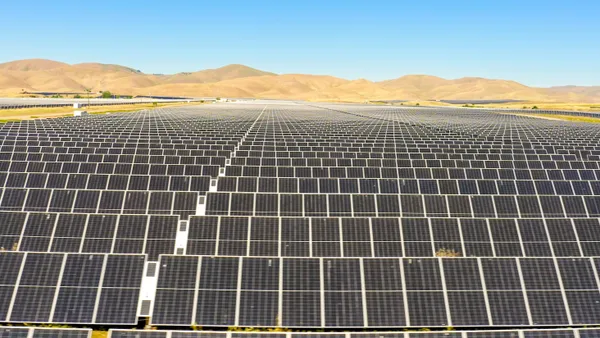Utility-scale solar has become an important and growing part of the electric generation portfolio in the Unites States. Existing or “traditional” utility-scale solar is designed and operated to generate and deliver the maximum amount of electricity in real time. Operational challenges are becoming evident in markets with high penetrations of traditional utility-scale solar. These challenges include variable output, lack of robust ancillary services, and dispatch limitations.
A common response to this challenge is to simply pair traditional utility-scale solar with flexible natural gas generation. However, this is not the only option. Utility-scale solar holds the potential if operated differently to address some of these issues on the electric grid by itself. “Controllable” utility-scale solar may emerge in the near term as a resource to support electric grid operations. Controllable utility-scale solar uses existing technology to provide additional value and flexibility through targeted curtailments, smoother output, and expanded ancillary services.
Over the long term, “smart” utility-scale solar may become a dominant and valued grid asset. Smart utility-scale solar systems go a step further by cost competitively offering operational attributes comparable to conventional generation. This would include providing energy capacity during evening and nighttime load. To make this a reality, smart utility-scale solar would consist of solar PV plus storage (PV+S).
The Solar Trifecta: A Path to Smart Utility-Scale Solar
Smart utility-scale solar could become a reality with the convergence of three important market requirements, which we call the “solar trifecta.” The three pillars of the solar trifecta are:
Value from Good Grid Citizenship – A common view is traditional utility-scale solar has not been a good grid steward because the resource is variable and the generation asset does not provide a broad suite of ancillary services (e.g., regulation, frequency response, etc.). As a result, other resources are required to respond to solar-related grid integration challenges. Recent demonstrations show solar PV can provide nearly constant output. This is done by designing in additional capacity and controlling the system to meet the interconnection limit (e.g., operating below maximum capacity). When this is done, blocks of inverters can be ramped up to mitigate passing cloud cover, resulting in nearly constant net output. In a sense, this makes solar dispatchable within a range of operation. Demonstrations have also shown the capability to provide a suite of ancillary services by trading energy output in favor of regulation (both up and down) and frequency response. And targeted curtailment can allow grid operators to better manage ramps in net load. In many instances, utility-scale solar is already providing dynamic voltage and power factor regulation based on bulk power system interconnection requirements.
Energy When You Need It – By exporting all available generation in real time, traditional utility-scale solar is unable to meet evening and nighttime load. PV+S addresses this challenge by providing energy and capacity during these time periods. The impact of storage is significant. A recent analysis of hourly system data over 20 years has shown that PV+S systems can be more cost effective than previously thought when “smartly” targeting the actual hours and load when they are needed. A PV+S system can increase the overall capacity factor during summer evening load from 50% to 98%.
Cost-Competitive Resource – The installed cost of fixed-tilt utility-scale solar has dropped 37% since 2015 and remains below $1/W-dc. Solar for energy alone has reached cost competiveness. Operating below maximum capacity in order to provide other services is also reaching financial parity in some regions. For total smart utility-scale solar to become cost competitive will depend on continuing to reduce the installed cost of utility-scale solar and battery pack costs. We have seen dramatic reductions to date. For instance, the cost of battery storage packs declined 73% from 2000 to 2016. And in May 2017, Tucson Electric Power signed a PV+S PPA for less than 4.5 cents per kWh. Continuing this decline in technology costs will be a key driver for PV+S project costs.
The Dawn of Smart Utility-Scale Solar
The solar trifecta provides a clear pathway toward achieving smart utility-scale solar. As an intermediate step, grid citizen advancements and continued solar PV cost declines will support the emergence of controllable solar, even without storage.
How Utility-Scale Solar Evolves to Meet Solar Trifecta Requirements*
| Type of Solar | Value from Good Grid Citizen | Energy When You Need It | Cost-Competitive Resource** |
|---|---|---|---|
| Traditional | No | No | Yes |
| Controllable | Yes | No | Yes |
| Smart | Yes | Yes | Yes |
* Table reflects requirements met by each type of solar; not necessarily current state of market.
** Cost competitiveness is dependent on location and available solar resource.
However, several market developments and regulatory decisions could hamper or accelerate advancement of the solar trifecta and ultimately the deployment of controllable and smart utility-scale solar. Key signposts to watch include:
- Recognition of value for good grid stewardship – Most PPA structures do not compensate or set minimum requirements for solar assets to provide broad ancillary services. New and innovative PPA structures or market rules could accelerate the learning curve and encourage future utility-scale solar systems to be model grid citizens.
- Success of early PV+S systems – For evening and nighttime dispatchable solar to gain broad industry acceptance, early PV+S systems must prove their ability to reliably and consistently deliver energy and capacity during evening load periods.
- Continued learning curve effects – With increasing installed capacity, both solar PV and battery storage costs have benefited from learning curve effects as installed capacity grows. Continued improvements in technology will be important if smart solar is to become cost competitive.
So, what are the key milestones that will mark the dawn of a new era for the electric grid? An initial and important milestone will be controllable utility-scale solar becoming commonplace, replacing the adoption of traditional utility-scale solar. Longer term, PV+S systems will outcompete new natural gas peaking plants and successfully provide energy, capacity, and a broad set of ancillary services.
For a more detailed discussion of the solar trifecta, please view our new whitepaper: The Solar Trifecta: A Path to Smart Utility-Scale Solar.










